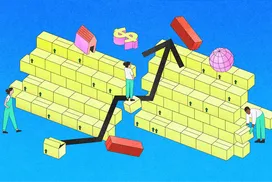Table of contents
This article is for educational purposes and does not constitute legal, financial, or tax advice. For specific advice applicable to your business, please contact a professional.
The retail industry is in a constant state of change. From growing consumer pressures to the juggling act of eCommerce and bricks and mortar, today’s retailers continue to adapt their business models to meet the needs of customers. So what does that means for supply chain sourcing?
Sourcing is the act of finding suppliers who can provide the products you need to meet your sales and operating goals. It involves evaluating suppliers based on criteria such as quality, cost, reliability, and ethical standards. Sourcing also includes negotiating contracts, managing supplier relationships, and ensuring a secure and reliable supply of goods to keep your business running.
These supplier relationships play an essential role in your supply chain. They require a delicate balance of procuring high-quality goods from vendors you can rely on year after year, while sourcing them at a cost that provides profitable margins.
To do this, a seamless pipeline that ensures reliability and quality despite uncertainties that may lie ahead for your supply chain is vital. These are the steps businesses should take to identify requirements, vet suppliers, and manage those relationships for long-term success.
Identifying your customer’s needs
The first step in the sourcing process is to figure out what you actually want to source. What are the items your customer wants to buy, and what do you need to do to get those items on your shelves?
Retailers often use software or third-party apps, like Faire, and their online marketplaces to discover new products. Square for Retail helps streamline this process by connecting your apps to work together seamlessly.
Keep in mind that your inventory needs may change over time and should be continuously evaluated. For example, sustainability may not have been on your list years ago, but today it is a top priority for many retailers. Ethical sourcing policies and assessing a suppliers’ social and environmental practices is important to both business owners and consumers, with research indicating that 84% of customers citing poor environmental practices would alienate them from a brand.
If ethical sourcing is important to your target consumer, start you supplier assessment with a market analysis on potential suppliers. The Sourcing Industry Group (SIG) offers the following advice for creating ethical sourcing standards:
- Understand and maintain a relationship with vendors throughout your entire supply chain, not just your tier-one suppliers.
- Look to other members of your community for success stories and follow their lead when implementing ethical sourcing practices.
- Take advantage of technologies, such as the Square for Retail vendor sales report, to stay on top of predetermined sustainable sourcing KPIs.
Narrowing down your suppliers
Once you’ve honed in on your customers’ demands, develop supplier requirements that also fulfill your other fundamental business needs. These criteria help to determine things like the quality, price, and delivery times. Here are a few requirements to consider:
- Can they fulfill custom requests?
- Do they have minimum order quantities?
- Is exclusivity important to you?
- Do they have a fair defect policy, and are you willing to eat the cost of damaged products if they don’t?
- Is the supplier sustainable and ethical?
Setting these requirements before committing to suppliers will help you avoid supply chain problems down the line. When selecting a supplier, you should measure their performance against a set of criteria. These criteria can vary in importance depending on your business and should be used to establish how well a supplier meets your unique needs. These criteria can include:
- Cost
- Quality
- Reliability
- Performance delivery
- Financial strength
- Responsiveness
- Flexibility
- Social and environmental practices
- Culture
Auditing your suppliers
Once you’ve identified your business needs and researched potential suppliers, you’re ready to audit your top candidates. This means meeting with a handful of vendors with the best proposals to determine if a vendor is the best fit for your business.
Carrying out due diligence is non-negotiable when identifying suppliers. It ensures potential vendors are legitimate and trustworthy. Its also a time to evaluate supplier capabilities, production capacity, and financial stability. Conducting on-site supplier visits, if possible, can also be helpful when evaluating suppliers.
A simple credit check is a great starting point to ensure they have the cashflow to make good on their promises. You can also check business registrations and public records to validate accreditations, and you can even ask for samples of products to assess their quality.
Assessing a supplier’s track record and performance history is also important. The best way to do this is to ask for customer reviews or references. If a supplier is not willing to provide customer testimonials or references, this can be a red flag that they are hiding something.
You should also conduct an independent search, which could be something as simple as a Google search or reading online supplier forums.
Negotiating contracts and terms
Negotiating a fair contract with your suppliers is essential to ensure every party makes good on their promises. Contracts should detail what the supplier will deliver and when. It should also make clear what they need in return from you (i.e., pricing) and what will happen if the agreed-upon contract is broken. Negotiating favorable terms, pricing, and payment conditions can be intimidating, but if done right, it can be a cost-saving measure. Vendors will often negotiate on their standard prices, but knowing how to approach and ask for changes is key. Using data and market research to prepare for your negotiations will help you land on a mutually beneficial terms. When preparing for you negotiations, consider the following:
- Past and current market data, including cost comparisons from other suppliers
- Based on your demand forecasting, consider your expected purchasing patterns
- If you’ve worked with a supplier before, include their performance against pre-determined goals
It’s important to understand the supplier’s motives so you can negotiate a contract that’s appealing for both parties. For example, offering a marketing opportunity in exchange for price concessions, decreasing the supplier’s risk with a long-term contract (including performance goals that are required to uphold the contract), or consolidating purchase orders.
Doing your homework to understand what you need from the vendors and how you can provide value to them will give you the negotiating power required to secure a strategic partnership.
Supplier relationship management
Building strong relationships with solid suppliers can make or break your supply chain. Not only communicating your strategic business objectives, but staying in the loop on their priorities and challenges can open the door to opportunities that can be mutually beneficial for both parties.
A big part of building those relationships is establishing alignment around KPIs, having clear directives, and creating efficient systems for purchasing, inventory management, and payment procedures.
Square for Retail helps sellers identify those KPIs with reliable insights to gain clarity on business performance and take action from real-time data. Businesses can also manage their inventory, vendors, and more from any first-party or personal device, syncing instantaneously.
Building a change-ready supply chain
Retailers are constantly working to meet their customers wherever they are, while also managing the changing economic and political climates. And much like retail, supply chain management is an always-changing process. Sourcing, too, requires continuous improvement, driven not only by the needs of your customers, but shifting marketplace pressures.
It is vital that your sourcing partners are prepared to address these potential disruptions and mitigate risks down the road. Understanding customer expectations and seasonality to plan accordingly requires the right set of tools. To be successful, retailers need to develop agile and flexible systems that do more than help them to sell. Your agile supply chain needs to be informed by data with streamlined inventory operations as you expand across multiple selling channels, creating greater reliability and accuracy.
Square for Retail provides that agility with automated tools that monitor quality, track performance, and generate more accurate forecasts with real-time reporting. Businesses are also able to confidently manage vendors and diversify their supplier base to reduce dependency on a single source and build a more resilient and flexible supply chain network.
Times are changing, and your supply chain should be, too. That starts with your sourcing practices and choosing suppliers that can not only fill your inventory needs but also fit into an agile supply chain model.
![]()









